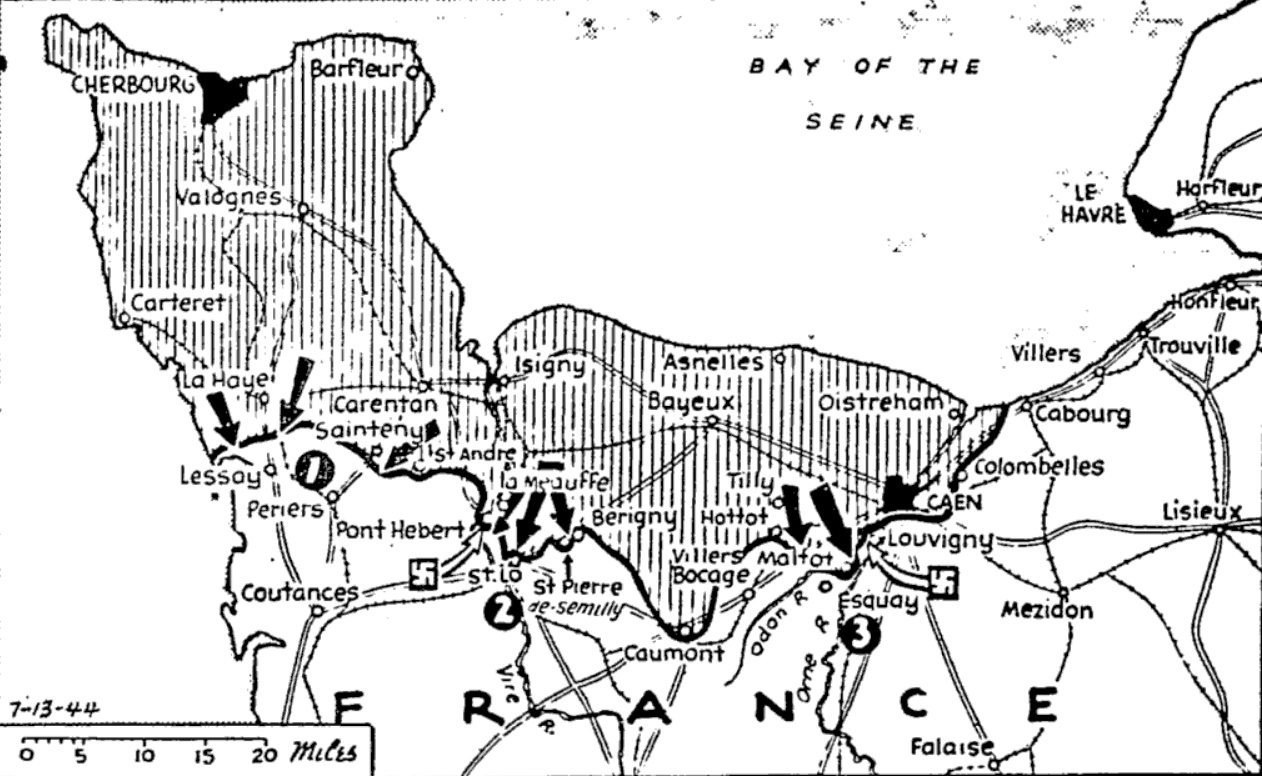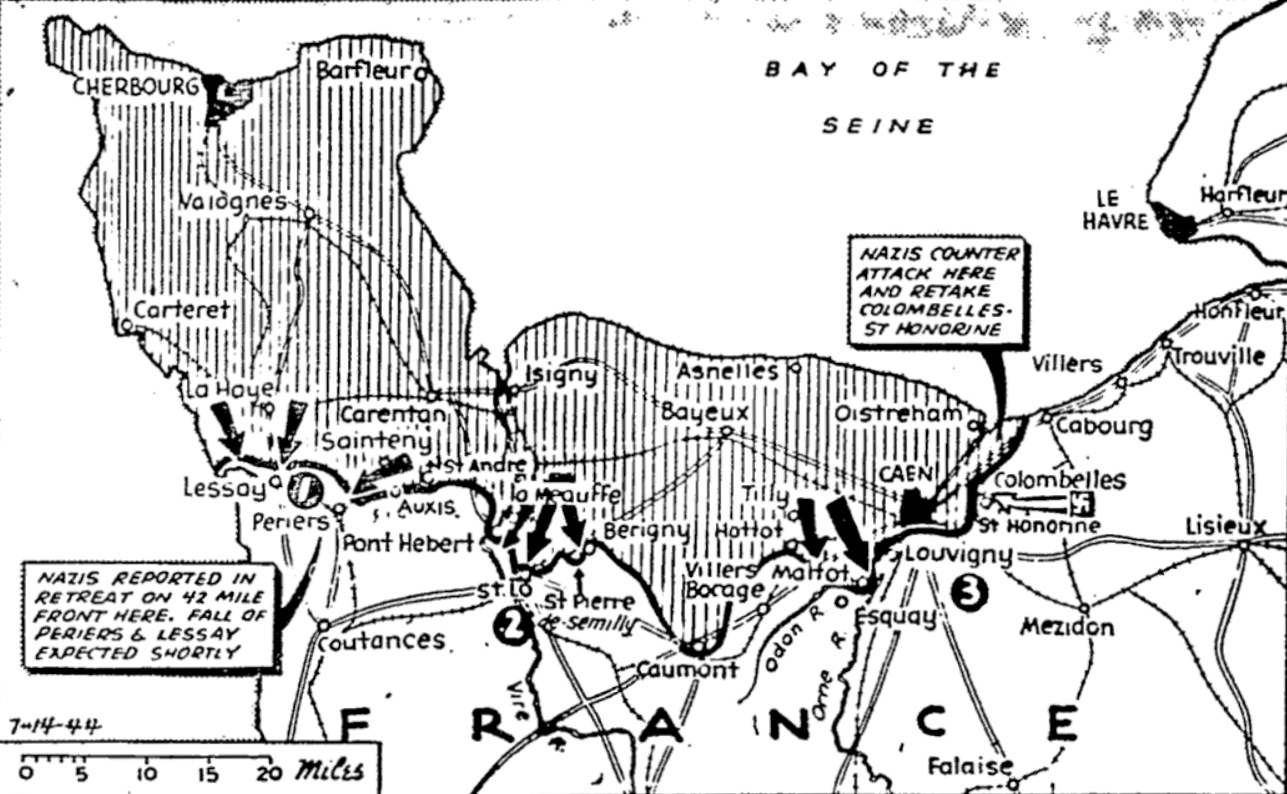The Pittsburgh Press (July 13, 1944)
YANKS STORMING INTO SAINT-LÔ
U.S. advance threatens two other bases
Americans nearing Lessay and Périers
By Virgil Pinkley, United Press staff writer
U.S. attack on Saint-Lô highlighted the news from Normandy today. The westernmost U.S. forces threatened Lessay and Périers after capturing a height commanding approaches to those towns (1), while advance patrols of Americans battled into the outskirts of Saint-Lô (2). Another U.S. column outflanked Saint-Lô with capture of Saint-Pierre-de-Semilly. In the Caen sector (3), the British recaptured Maltot.
Nazis reported using robots against Yanks
With U.S. forces in France (UP) – (July 1, delayed)
The Germans were reported today to have used pilotless planes against U.S. troops in the frontlines for the first time.The first reports of the German use of pilotless planes said a few had been in action against the Americans fighting alongside the British flank at the center of the Normandy line.
The above dispatch from United Press writer James McGlincy lacked immediate amplification. The dispatch was filed July 1, but as received in New York, it bore no explanation of the delay.
SHAEF, London, England –
The U.S. 1st Army blasted and bayonetted its way to the outskirts of Saint-Lô today and hammered out general advances of about a mile all along the Normandy front to threaten the German keystone defense bases of Lessay and Périers.
While Lt. Gen. Omar N. Bradley’s left wing closed on Saint-Lô in some of the bloodiest fighting of the French campaign, his assault forces battered forward in at least seven sectors, cleared the entire La Haye-du-Puits–Carentan railroad and highway, and completed the conquest of the sprawling swamp area called Prairies Marécageuses de Gorges.
Lessay under fire
In the west coast sector, U.S. forces overrun the strategic Hill 92, commanding the entire area of Lessay and bringing that key transport junction under direct fire.
The last “bloody mile” into the heart of Saint-Lô, hinge of the German defenses on the Normandy front, shook under a thunderous artillery and infantry attack as the doughboys drove spearheads to the east and northwest of the city, setting the stage for a possible encirclement of the stubbornly-defended hilltop citadel.
As the foremost elements slugged to the outskirts, a column striking upstream along the west bank of the Vire from Pont-Hébert advanced a mile south of that village to a point three miles northwest of Saint-Lô.
Straightening U.S. line
The advances of 300 yards, to more than a mile, were gradually straightening out the American line and eliminating the marshland salient, with the battlefront now stretching along a line running northwest to southeast from Lessay to Saint-Lô.
The Americans captured Nay (three and a half miles northeast of Périers), Saint-André-de-Bohon (four and a half miles south of Carentan) and Gornay (north of the woods known as Bois de Hammet, through which U.S. troops were advancing after squeezing out the last of the Germans.
Between Saint-André-de-Bohon and Sainteny, gains of 500 yards on a one-mile front carried to the edge of inundated territory and broadened the U.S. front about half a mile westward near Pont-Hébert.
Set for frontal assault
After rushing the Germans off Hill 92, dominating the approaches to Lessay, the Americans pushed some 300 yards down its south slopes and drew into position for a frontal assault on the town anchoring the German coastal positions.
The Germans still showed no signs of any large-scale withdrawal anywhere along the Normandy front. Headquarters sources expected that if and when such a withdrawal comes, it is more likely to be on the American front than the British, because Gen. Bradley’s forces were chopping gradually but steadily through the enemy communication system.
Everywhere along the American line, the battle was a story of relentless chopping away at entrenched Germans under cold, drab skies that almost grounded the Allied air arm again today.
British sector quiet
The British-Canadian end of the Normandy front was relatively quiet as Lt. Gen. Sir Miles C. Dempsey regrouped his forces for another blow to shatter Marshal Erwin Rommel’s tightly stacked defenses northeast and southwest of Caen.
The main blow on Saint-Lô was aimed down the highway running into Saint-Lô from Bayeux, to the northeast, but other columns were converging from the north and northwest and still another force outflanked the city with a push through Saint-Pierre-de-Semilly, three and a half miles to the east.
Seventeen towns and villages were seized by the Americans yesterday while the British 2nd Army recaptured Maltot, five miles southwest of Caen, and hurled back 90 tanks which threw themselves against the salient between Odon and Orne Rivers in two futile counterattacks yesterday.
The Germans counterattacked northwest of Saint-Lô, but were beaten off and the American advance resumed.
Surrender appeal made
Last night, Allied transmitters and sound trucks in the Saint-Lô area broadcast an appeal to the Germans to lie low in the grass when the American attack was launched and then surrender as U.S. troops came abreast of them. in this way, the broadcasts said, the Germans could shield themselves from the fire of their own forces.
So far there were no reports indicating the success of the maneuver.
German paratroopers, among the toughest Nazi units, fiercely resisted the advance and fighting raged at such close quarters that at some points the Americans were on one side of a hedgerow and the Nazis on the other.
Grenade over hedge
A dispatch said:
At one place, a German reached over a hedge and tossed a hand grenade at a company commanding officer and killed him. That’s how close the fighting is.
Once Lessay, Périers and Saint-Lô have been captured, the Germans must fall back as much as 12 miles to a new line anchored off Coutances because of the lack of natural defenses in the intervening terrain.
British forces were reported to have knocked out a large percentage of the 90 tanks which German Marshal Erwin Rommel hurled against them in two counterattacks southwest of Caen. At least 84 German panzers were destroyed or damaged by Allied planes and ground forces Tuesday and the British successes yesterday probably boosted the total for the 48-hour period to more than 100 and for the past five days to nearly 200 – well over the equivalent of a full German armored division.
Heavy fighting was also reported around Hottot, two miles below Tilly-sur-Seulles at the hinge of the British salient across the Odon River.
German ace killed
London, England –
Lt. Eugen Zeigert, one of Germany’s leading air aces who claimed to have shot down 69 Allied planes, has been killed on the Western Front, the German radio reported today.


